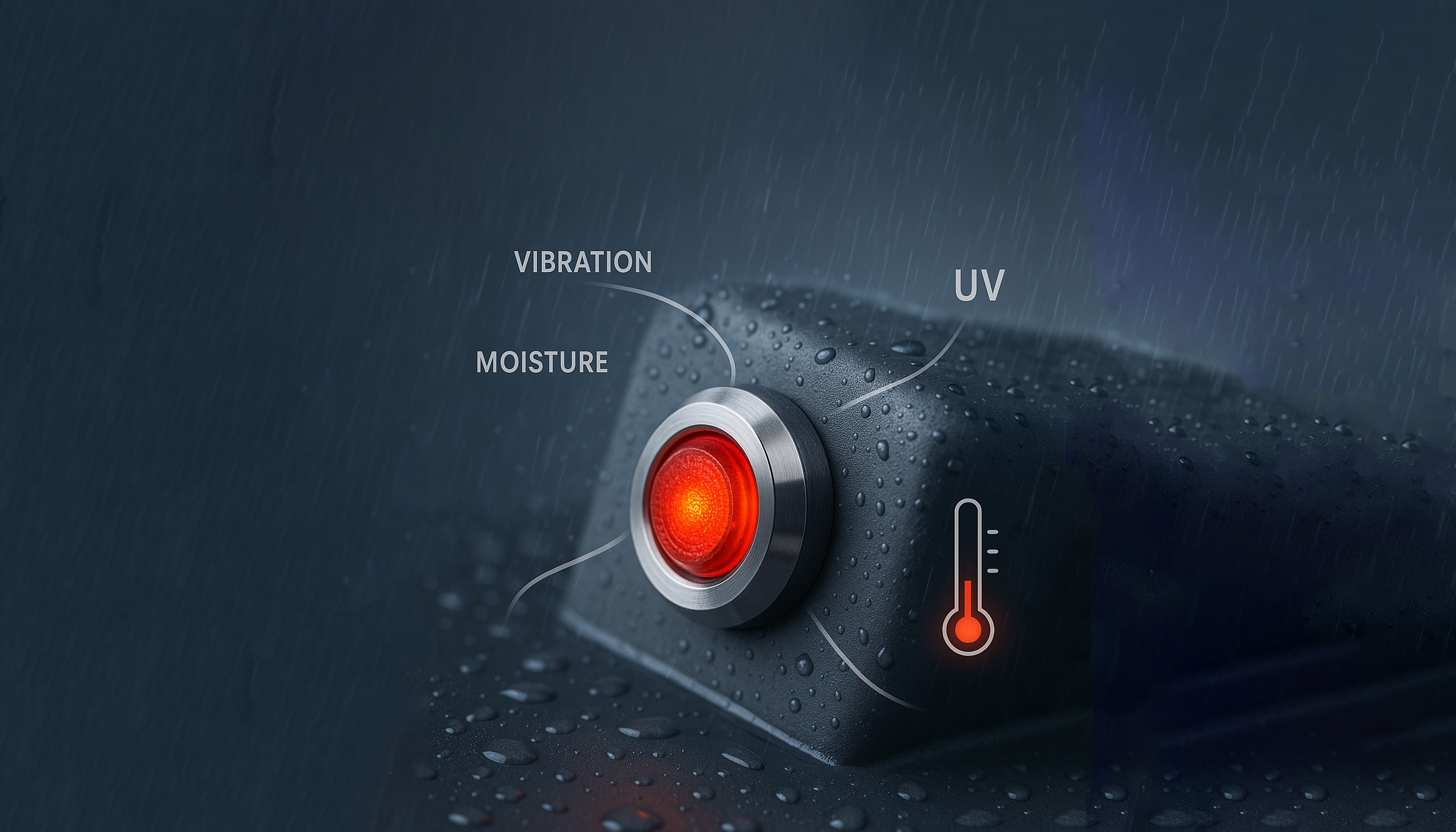
Why choosing the right indicator matters
In critical applications, a faulty LED indicator isn’t just an inconvenience; it can cause downtime, safety hazards, or even catastrophic failures. When equipment operates in harsh environments, standard LED indicators won’t cut it. From industrial machinery exposed to extreme temperatures and corrosive chemicals to outdoor signage battling UV radiation and driving rain, selecting the right LED indicator is crucial for reliability and longevity. This article will guide engineers and purchasing teams through the key considerations for evaluating LED panel mount indicators (PMIs) designed to withstand the most challenging conditions.
Environmental Challenges: An Overview of Common Conditions (IP Rating, UV, and Shock)
Harsh environments present many challenges to electronic components. Understanding these everyday environmental stressors is the first step in choosing the right LED indicator:
● Temperature Extremes: High heat can degrade LED performance and shorten lifespan, while extreme cold can affect material properties and cause brittle components.
● Moisture and Contaminants (IP Rating): Water, dust, oil, and chemicals can enter inadequately sealed indicators, causing shorts, corrosion, and system failure. An IP (Ingress Protection) rating is crucial here, indicating the degree of protection against solids and liquids.
● Vibration and Shock: Equipment in industrial, vehicle, or aerospace applications often experiences high vibration and mechanical shock, which can loosen connections or damage internal components.
● UV Radiation: Prolonged exposure to ultraviolet (UV) light, particularly in outdoor applications, can cause plastics to degrade, yellow, or crack, compromising the indicator’s integrity and aesthetics.
● Corrosive Substances: Exposure to acids, alkalis, solvents, and other caustic chemicals can cause damage to housing materials, seals, and electrical contacts.
● Pressure Variations: For specific applications, significant changes in atmospheric pressure can cause stress in sealed components.
Key Specs to Evaluate: Viewing Angle, Brightness, Ingress Protection, and Mounting
Beyond the general environmental challenges, the technical specs of the LED indicator must be evaluated to ensure optimal performance in harsh conditions:
● Viewing Angle: The viewing angle determines the extent to which the light can be seen. For applications where operators will view the indicator from various positions, a wider viewing angle is essential to increase visibility and safety.
● Brightness: Measured in millicandela (mcd), brightness is crucial for visibility in various ambient light conditions. Higher brightness is generally required for outdoor use or brightly lit environments to produce a more precise and brighter indication.
● Operating Temperature Range: Ensure the specified operating temperature range of the LED indicator exceeds the maximum and minimum temperatures of your specific application, especially in areas with high heat or cold.
● Shock and Vibration Resistance: Look for indicators that have been tested to relevant industry standards for shock and vibration (e.g., MIL-STD-202), ensuring they maintain function in harsh environments with constant movement.
● Voltage and Current Requirements: Verify compatibility with your system’s power supply to ensure proper operation, prevent premature failure, and optimize energy consumption and efficiency.
● Lifespan: LEDs are known for their long lifespan, but operating conditions can impact this. Check the specified lifespan.
These are the key considerations when choosing LED indicators for harsh environments, for proven reliability and performance in your application.
Design Considerations: Panel Thickness, Lens Material, and Housing Shape
When using LEDs to design panel mount indicators (PMIs), it’s essential to consider not only the LED’s electrical and optical properties but also how the physical design of the indicator will perform in harsh environments. The integration of the LED into the panel requires careful attention to the mounting structure and materials to ensure durability, reliability, and optimal visibility. Key design factors include:
● Panel Thickness Compatibility: The indicator must be compatible with the panel thickness to ensure a secure fit without causing stress or deformation that could compromise sealing or performance.
● Lens Material: Choosing the right lens material is critical for resistance to UV exposure, chemicals, and impact. Common materials include polycarbonate for toughness and acrylic for clarity, both often treated for UV resistance.
● Housing Shape and Size: The shape and size affect mounting options and the ability to withstand mechanical stresses. Compact, rounded housings often provide better resistance to shock and vibration.
● Sealing and Gaskets: Proper sealing with high-quality gaskets ensures protection against dust, moisture, and contaminants, maintaining the IP rating in demanding environments.
● Thermal Management: Design must allow for adequate heat dissipation to prevent overheating, which can reduce LED lifespan and performance.
● Mounting Method: Panel mount indicators may use snap-in, threaded, or soldered mounting. Each method offers different levels of security and ease of installation, impacting durability.
● Wire and Connector Quality: Robust wiring and connectors designed for harsh conditions prevent failures due to vibration, corrosion, or mechanical wear.
Considering these design factors helps ensure that LED indicators will maintain their function, safety, and longevity in harsh and extreme operating conditions.
VCC Solutions: Highlight rugged LED PMIs Lighting Solutions
At VCC, we know harsh environments. Our range of rugged LED PMIs is designed to perform where standard indicators fail. Our solutions feature:
● High IP Ratings: Many of our LED PMIs have IP67 or IP68 ratings, providing complete protection against dust and water.
● Robust Construction: Our indicators are constructed from high-grade materials, including stainless steel, anodized aluminum, and UV-stabilized polycarbonate, ensuring they can withstand extreme temperatures, shock, and vibration.
● Wide Operating Temperature Ranges: Designed for operation in various climatic conditions, from arctic cold to desert heat.
● Excellent Optical Performance: Wide range of viewing angles and brightness levels for clear indication in any lighting condition.






